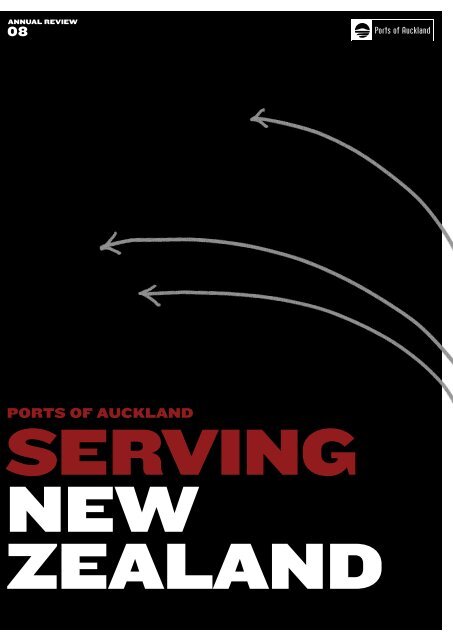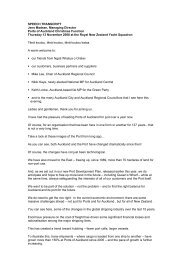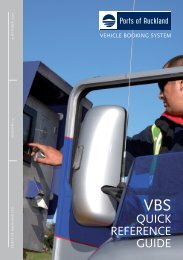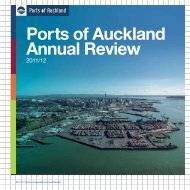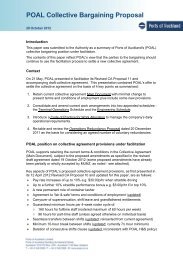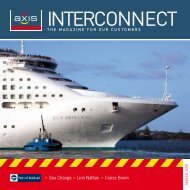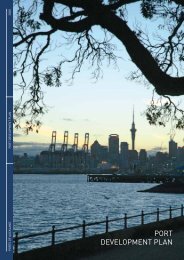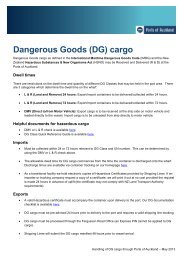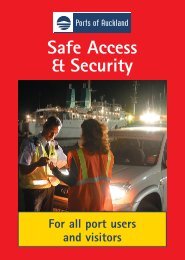2007-2008 - Ports of Auckland
2007-2008 - Ports of Auckland
2007-2008 - Ports of Auckland
You also want an ePaper? Increase the reach of your titles
YUMPU automatically turns print PDFs into web optimized ePapers that Google loves.
leadershipTo lead <strong>Ports</strong> <strong>of</strong> <strong>Auckland</strong> – an iconic New Zealand company andone with a rich and varied history – is both a great privilege andan exciting responsibility.1,738SHIP CALLS$23bEvery day, four or five international vessels berth at our <strong>Ports</strong>, bringingthe world’s goods to our doorstep and taking New Zealand’s tradeto global markets. Increasingly, <strong>Auckland</strong> is also becoming a hub port,through which cargo destined for other Australasian ports is shipped.As the leading container port in a small country remote fromthe world’s major trading centres in Asia, Europe and America, <strong>Ports</strong><strong>of</strong> <strong>Auckland</strong> is pivotal to New Zealand’s economic wellbeing.By a significant margin, the Port <strong>of</strong> <strong>Auckland</strong> is the country’slargest container port. We handle nearly half <strong>of</strong> the entire country’sfull import containers and more than a quarter <strong>of</strong> New Zealand’sfull export containers. The vast majority <strong>of</strong> New Zealand’s importedcars come through our General Wharves, from which we also servethe important Pacific Island trade. <strong>Auckland</strong> is also the country’spremier cruise port, helping secure significant tourism revenue forthe regional economy.In an environment where entire supply chains are in competitionwith each other, <strong>Ports</strong> <strong>of</strong> <strong>Auckland</strong>’s ability to <strong>of</strong>fer world class serviceto our customers, and to foot it with the best ports in the world, isincreasingly important to New Zealand’s future.<strong>Ports</strong> <strong>of</strong> <strong>Auckland</strong> has been here since 1871 and, over thatperiod, has seen many changes and innovations. Most recently wehave focused on intensifying and consolidating our operations,enabling a move eastwards and freeing up land for public accessand leisure use to the west.However, the pace <strong>of</strong> change has never been faster than it is now.We must adapt, and are adapting – with energy and resilience – to thechanging world and challenging economic climate around us.This Annual Review, with the complementary SustainabilityReview, demonstrates not only the breadth <strong>of</strong> our operations and thecomplexity <strong>of</strong> our business, but <strong>Ports</strong> <strong>of</strong> <strong>Auckland</strong>’s commitment tolifting performance to world class levels – in terms <strong>of</strong> productivity,customer service, health and safety, and environmental management,and in our relationships with our local community and our staff.We are committed to making our Vision – to be the best portin Australasia, with world class performance – a reality. To do this willrequire not just smart thinking and determined action on our part, butthe participation and engagement <strong>of</strong> all our stakeholders – customers,community and business partners – in our plans and initiatives.We look forward to enduring partnerships with our stakeholdersas we help to connect New Zealand to the world.worth <strong>of</strong> nEW zEALAND imports and exportsGary Judd Q.C.ChairmanJens MadsenManaging Director
0204060810121416Serving New Zealand<strong>Ports</strong> <strong>of</strong> <strong>Auckland</strong> Annual Review <strong>2008</strong><strong>Ports</strong> <strong>of</strong> <strong>Auckland</strong> has a number <strong>of</strong> natural advantages whichmeans that it is ideally positioned to serve New Zealand, now andin the future.Most important is our close proximity to <strong>Auckland</strong> – New Zealand’shub and largest regional economy. Home to two-thirds <strong>of</strong> thecountry’s top 200 companies, <strong>Auckland</strong> is also New Zealand’sfastest-growing region.Also important is <strong>Auckland</strong>’s natural deep water harbour which,following recent channel deepening, already has the ability to caterfor the next generation <strong>of</strong> larger container ships.With two seaports – one on the east coast in the <strong>Auckland</strong>central business district, the other on the west coast in Onehunga– and a strategically located inland port at Wiri, South <strong>Auckland</strong>,<strong>Ports</strong> <strong>of</strong> <strong>Auckland</strong> can connect New Zealand businesses with 164international ports in 67 countries.how we deliver• The Port <strong>of</strong> <strong>Auckland</strong>, New Zealand’s largest container portby volume and value, on the Waitemata Harbour near <strong>Auckland</strong>’sCBD, and the Port <strong>of</strong> Onehunga, a domestic port on theManukau Harbour• An inland port at Wiri, South <strong>Auckland</strong>, close to SH1 and SH20,providing road, yard, e-commerce, MAF and Customs functionsAnd in <strong>2008</strong>, connect we did, handling a record 840,00020 foot equivalent container units (TEU) – representing more than athird <strong>of</strong> New Zealand’s total container trade and $23 billion worth <strong>of</strong>exports and imports. We also handled 3.6 million tonnes <strong>of</strong> bulk andbreakbulk (non-containerised) cargo, including more than 173,000vehicles, and hosted 70 cruise ship calls.Of course natural advantages are not enough. They must becomplemented with a commitment to world class performance,innovation and technology. <strong>Ports</strong> <strong>of</strong> <strong>Auckland</strong> is working hard on allfronts to enhance capacity, lift productivity and create a leaner andgreener supply chain.• The country’s best crane intensity – eight cranes acrosstwo terminals – and the newest, largest and most efficient straddlecarrier fleet• Facilities for a range <strong>of</strong> bulk and breakbulk cargos, including fivegeneral cargo wharves and a bulk liquid terminal• The country’s premier exchange port for cruise ships and hostfor New Zealand’s only winter cruise season• Towage, pilotage and linesman services on the Waitemata andManukau harboursour strategic partners• A 19.9% stake in Northland Port Corporation (NZ) Ltd, whichpart-owns Northport Ltd• A 50.0% share <strong>of</strong> North Tugz Ltd• A 27.5% holding in United Containers Ltd, one <strong>of</strong> New Zealand’slargest container depot operators
FINANCIAL HIGHLIGHTSPORT OPERATIONS EBIT$ MILLION63.2 58.9 62.3 51.6 52.8PORT OPERATIONS REVENUE$ MILLION150.0 149.3 159.3 163.1 169.4$21.1mnet PROFIT AFTER TAX$169.4mPORT OPERATIONS REVENUEO4 O5 O6 O7 O8O4 O5 O6 O7 O8IN REVIEW• Total port operations revenue increased3.9% to $169.4m655239ORDINARY DIVIDENDS PAID DURING THE YEARPORT $ MILLION OPERATIONS EBIT ($M)$'00036.0 42.9 31.8 19.9 22.8170156142SHAREHOLDER’S EQUITYPORT $ MILLION OPERATIONS EBIT$'000393.7 651.7 546.7 330.5 398.1• Port operations EBIT increased 2.3%to $52.8m and port operations EBITDAincreased 5.3% to $71.9m• NPAT <strong>of</strong> $21.1m compares to <strong>2007</strong> NPAT<strong>of</strong> $64.6m (restated from $61.1m), whichincluded rental income from leases <strong>of</strong> theWestern Reclamation property portfolioand a gain on the transfer <strong>of</strong> the portfolioto <strong>Auckland</strong> Regional Holdings (ARH)2613128114• Total container volumes increased 8.8 %to 840,993 TEU (20 foot equivalent unit)0O4 O5 O6 O7 O8O4 O5 O6 O7 O8100O4 O5 O6 O7 O8O4 O5 O6 O7 O8• Bulk and breakbulk volumes increased2.4% (this excludes Wynyard Wharfvolumes following the transfer <strong>of</strong> theWestern Reclamation property holdingto ARH on 1 April <strong>2007</strong>)DIVIDENDS PAID$'000SHAREHOLDERS EQUITY$'000• Ordinary dividends paid to <strong>Auckland</strong>Regional Holdings during the financialyear were $22.8m4565036520273901826091300O4 O5 O6 O7 O80O4 O5 O6 O7 O8
0204060810121416PREPARING FOR THE FUTURE<strong>Ports</strong> <strong>of</strong> <strong>Auckland</strong> Annual Review <strong>2008</strong>Despite New Zealand’s isolation from the rest <strong>of</strong> the world, we arecloser than ever before to our trading partners. Advances in shippingand port operations mean New Zealand goods can go from port tooverseas market, and vice versa, in a matter <strong>of</strong> just days or weeks.And as shipping lines, services and ports consolidate and rationalise,the global shipping community is shrinking and powerful industryplayers are emerging.There is a global trend towards bigger ships. Since 2004, theaverage TEU volume per container ship call has increased 20% andit won’t be long before we see the next generation <strong>of</strong> larger containervessels in New Zealand waters. As ships get bigger, they call less<strong>of</strong>ten and to fewer ports – and from this comes hubbing.This environment creates opportunities, but also significant risks,not just for <strong>Ports</strong> <strong>of</strong> <strong>Auckland</strong> but for New Zealand as a country. Indeedour interests are interlinked: 48% <strong>of</strong> the North Island container trade and36% <strong>of</strong> New Zealand’s total container trade moves through <strong>Auckland</strong>.Both inside our gates and outside them, <strong>Ports</strong> <strong>of</strong> <strong>Auckland</strong> istaking the lead, making sure we are prepared to serve New Zealandwell into the future.In recent years, we have made significant investments toenhance our capacity and logistics capability. As this new worldarrives, we are working to complement our existing advantages <strong>of</strong>scale and proximity to market with innovative projects and initiativesdesigned to cement our place as a leading Australasian hub port.These initiatives include new machinery, such as energy-efficientstraddle carriers and cranes with higher lifting capacities, a suite <strong>of</strong>new technology projects and major infrastructure developments.Worldwide, there is also growing pressure on companies todevelop and demonstrate their environmental consciousness. For atrading nation like New Zealand, doing so is essential. <strong>Ports</strong> <strong>of</strong> <strong>Auckland</strong>has taken a leadership role within the port and shipping industry, thisyear becoming one <strong>of</strong> the first Australasian ports to measure andindependently audit its carbon footprint. This work has provided a solidfoundation for our future focus on environmental efficiency. Furtherdetails are contained in our <strong>2008</strong> Sustainability Review.In terms <strong>of</strong> the entire supply chain, from raw material to finishedproduct to final consumer, the contribution <strong>of</strong> the Port to any product’stotal carbon footprint is relatively small. So, <strong>Ports</strong> <strong>of</strong> <strong>Auckland</strong> isalso collaborating with a wide range <strong>of</strong> industry stakeholders – fromcargo owners to freight forwarders and trucking companies – todevelop new initiatives that will help optimise the Upper North Islandsupply chain.A lean, green and logical supply chain will help secure our country’strade with the world – <strong>of</strong>fering the ‘speed to market’ as well as theenvironmental efficiency demanded by today’s markets and consumers.
DIGGING DEEPIn August <strong>2007</strong>, <strong>Ports</strong> <strong>of</strong> <strong>Auckland</strong> announced thecompletion <strong>of</strong> a major ‘future-pro<strong>of</strong>ing’ project – the<strong>of</strong>ficial opening <strong>of</strong> our new, deeper and wider shippinglane. At 12.5 metres at the lowest <strong>of</strong> low tides,<strong>Auckland</strong>’s commercial shipping lane now <strong>of</strong>fers widertidal windows for larger ships and the potential to caterfor vessels with a draft <strong>of</strong> up to 13.9 metres withoutthe need for significant dredging.The announcement marked the conclusion <strong>of</strong> thethree-and-a-half year, $69-million project that alsoinvolved a significant extension to <strong>Auckland</strong>’s maincontainer terminal. Dredgings from the shipping lanedeepening were recycled as fill for Stage One <strong>of</strong> theextension – a 5.8-hectare reclamation for the Fergussoncontainer terminal. The new operational area providescapacity for an additional 130,000 TEU per annum andhas enabled a range <strong>of</strong> measures to optimise use <strong>of</strong>space, including realigning container stacks androadways. This has in turn facilitated the introduction<strong>of</strong> dual-direction driving. By reducing the number <strong>of</strong>kilometres driven per container handled, we are alreadyachieving impressive gains in productivity andenvironmental efficiency.13.9metRE draft potential5.8hectares <strong>of</strong> new land83,638TEU MOVED BY RAILmarket shareNORTH ISLAND CONTAINER TRADEWORKING FOR A LEANER, GREENERSUPPLY CHAIN<strong>Ports</strong> <strong>of</strong> <strong>Auckland</strong> recognises that efficiency is justas important outside the Port gates as it is inside.The development <strong>of</strong> a short-haul rail servicebetween the <strong>Auckland</strong> seaport and Wiri Inland Portin South <strong>Auckland</strong> is one mechanism the Companyis pursuing to improve <strong>Auckland</strong>’s supply chain.The solution is a prime example <strong>of</strong> an integrated,multi-modal approach to transport planning, whereroad, rail and sea transport all work together tocreate a leaner and greener supply chain.The project includes an upgrade <strong>of</strong> the railsidings and the construction <strong>of</strong> a hardstandadjacent to the Company’s Wiri Inland Port, whichborders the North Island Main Trunk Line.The resulting service will enable a large portion<strong>of</strong> <strong>Auckland</strong>’s import containers to be moved by railto Wiri, and then trucked to local businesses. Weplan to have the rail service up and running midwaythrough 2009. Once up to speed it is forecast tosave 100,000 truck trips in and out <strong>of</strong> <strong>Auckland</strong>’sCBD per annum – or up to 2.5 million truckkilometres per year.UPDATED PORT DEVELOPMENT PLANFOR AUCKLANDKeeping pace with change and ensuring the<strong>Auckland</strong> seaport is capable <strong>of</strong> serving New Zealandwell requires a long planning horizon. This year, theCompany updated its Port Development Plan to theyear 2040, keeping operational needs and publicinterests top <strong>of</strong> mind.The plan is a high level strategic view <strong>of</strong> howthe Port will develop. It builds on the Company’s1989 plan and is consistent with the <strong>Auckland</strong> Cityand Regional Council-developed ‘<strong>Auckland</strong>Waterfront Vision 2040’.The refreshed plan examines the release <strong>of</strong>20land holdings, such as Queens Wharf, and theconstruction <strong>of</strong> new facilities for future capacityrequirements. Increasing the intensity <strong>of</strong> operations 16within the Port’s existing footprint and the addition<strong>of</strong> a new berth at the northern end <strong>of</strong> theFergusson container terminal are two key areas<strong>of</strong> focus in the short to medium term.1284<strong>Ports</strong> <strong>of</strong> <strong>Auckland</strong> 48%Other North Island ports 52%NEW ZEALAND CONTAINER TRADEPORT OPERATIONS EBIT$'000<strong>Ports</strong> <strong>of</strong> <strong>Auckland</strong> 36%Other ports 64%0O4 O5 O6 O7 O8
0204060810121416<strong>Ports</strong> <strong>of</strong> <strong>Auckland</strong> Annual Review <strong>2008</strong>CHAIRMAN’S REVIEWPort companies throughout New Zealand are facingsignificant pressures and challenges. Shipping lineconsolidation, capital investment requirements,increasing environmental imperatives, fluctuatingfuel prices, impacts on volumes caused by climaticconditions and macroeconomic factors combine tomake this industry a tough one.<strong>Ports</strong> <strong>of</strong> <strong>Auckland</strong> is continuing to address issuesproactively and constantly, looking for new and innovativeways to enhance performance.Financial performanceThis year’s annual result reflects a significant restructuring<strong>of</strong> <strong>Ports</strong> <strong>of</strong> <strong>Auckland</strong>’s balance sheet including a largeshareholder dividend in <strong>2007</strong>.Port operations revenue and other income increased3.9% to $169.4 million and reported port operationsearnings before interest and tax (EBIT) increased 2.3%to $52.8 million. Port operations earnings before interest,tax, depreciation and amortisation (EBITDA) increased
5.3% to $71.9 million. Port operations costs were up4.5% to $116.6 million.Dividends from Northland Port Corporation (NZ) Ltdincreased 84.8% to $2.0 million. Share <strong>of</strong> pr<strong>of</strong>its fromNorth Tugz Ltd and United Containers Limited holdingsincreased 103.6% to $3.4 million.Total earnings before interest and tax (EBIT) were$57.8 million. Interest expense increased 17.9% to$28.5 million reflecting a higher average bank debtlevel in the period. The final result was a net pr<strong>of</strong>it aftertax <strong>of</strong> $21.1 million compared to $64.5 million in theprevious period.The <strong>2007</strong> result included a one-<strong>of</strong>f revenuecontribution <strong>of</strong> $25.5 million from the sale <strong>of</strong> theWestern Reclamation Portfolio to <strong>Auckland</strong> RegionalHoldings and $5.3 million <strong>of</strong> earnings from tenants <strong>of</strong>this property. The transfer <strong>of</strong> the property resulted in an‘in specie’ distribution to <strong>Auckland</strong> Regional Holdings <strong>of</strong>$272.4 million.Shareholder funds and dividendsOrdinary dividends totalling $16.7 million were declaredto the Company’s sole shareholder, <strong>Auckland</strong> RegionalHoldings, a statutory investment management entityaccountable to the <strong>Auckland</strong> Regional Council. An interimdividend <strong>of</strong> $9.5 million was paid on 21 February <strong>2008</strong> anda final dividend <strong>of</strong> $7.2 million was paid on 21 August <strong>2008</strong>.In accordance with its accounting policy, <strong>Ports</strong> <strong>of</strong><strong>Auckland</strong> revalued its property, plant and equipment as at30 June <strong>2008</strong> resulting in a net increase in non-currentassets <strong>of</strong> $82.0 million. This revaluation combined withretained earnings resulted in an increase in shareholder’sfunds by 20.5% to $398.1 million.Capacity and capabilityCritical to the Port’s ability to compete as an internationalport is our ability to <strong>of</strong>fer capacity and capability that is insync with our customers’ needs.The Board and management are committed toongoing investment in port capacity and capability tocater for projected long-term growth, and to maximisethe value <strong>of</strong> the investments already made. In particular,a Capacity Project Team is examining technology optionsfor increasing container-handling capacity within thePort’s existing footprint.PeopleOn behalf <strong>of</strong> the Board, I would like to thank the Company’smanagement and staff for their commitment and focusduring the last year.We operate in a highly competitive environmentwhere traditional work practices have to be continuouslychallenged if we are to have an internationally competitive,sustainable business – and industry – in the long term.With this in mind, <strong>2008</strong> has been notable for theintroduction <strong>of</strong> a major people and culture initiative,Compass – a values programme that is designed toimprove collaboration, leadership and productivity acrossthe organisation.I would also like to acknowledge the appointment <strong>of</strong>Jens Madsen as Managing Director on 1 September <strong>2007</strong>.Mr Madsen joined <strong>Ports</strong> <strong>of</strong> <strong>Auckland</strong> in a newly createdposition <strong>of</strong> Chief Operating Officer at the beginning <strong>of</strong>2006, and was later appointed Chief Executive-designatein April <strong>2007</strong>. Mr Madsen brings a great deal <strong>of</strong>experience and expertise to the Managing Directorrole following a successful international career withA.P. Moller-Maersk that spanned 28 years and includeda posting as the first Managing Director <strong>of</strong> Maersk inNew Zealand.The Board <strong>of</strong> Directors, which is pr<strong>of</strong>iled onpages 10 and 11 <strong>of</strong> this Review, also welcomed twonew Directors this year. Emmet Hobbs was appointeda Director in September <strong>2007</strong> and Roger Gower inNovember <strong>2007</strong>. Both gentlemen have extensiveexperience at executive and board level in a range <strong>of</strong>transport and logistics companies.OutlookThere is much to be encouraged about in the result.While operating conditions are still challenging, wehave clear strategies in place to respond to the changingexternal environment.We are looking forward to increased containervolumes in the first quarter <strong>of</strong> 2009, flowing from aseries <strong>of</strong> recently announced shipping line changes.However, due to various international market pressureswe expect overall 2009 volumes to settle at a similarlevel to that <strong>of</strong> <strong>2008</strong>.At a macro level, <strong>Ports</strong> <strong>of</strong> <strong>Auckland</strong> welcomesincreasing central Government interest in ports policyincluding a strategy to revitalise domestic shipping(Sea Change), a Freight Demand Study and ongoing workto inform future Government investment decisions andmake best use <strong>of</strong> existing port capacity.From a New Zealand perspective, the <strong>Ports</strong>ector has a crucial role to play in the country’s futureeconomic performance. The answer lies in a cohesivenational strategy, aligned national interests, agility andinnovation. There is little doubt in our minds that we needto step up and <strong>of</strong>fer leadership within the port sector asNew Zealand responds to tough global and domesticeconomic conditions.Gary J. Judd Q.C.Chairman
0204060810121416<strong>Ports</strong> <strong>of</strong> <strong>Auckland</strong> Annual Review <strong>2008</strong>MANAGING DIRECTOR’S REVIEWIn this, my first review as Managing Director, I ampleased to share with you my confidence that <strong>Ports</strong><strong>of</strong> <strong>Auckland</strong> is responding rapidly and intelligently todramatic changes in the international shipping marketand global economy.Driven by an intensified focus by shipping lines to containunit cost, the international trend towards port hubbing hascontinued, with ongoing consolidation <strong>of</strong> shipping lines,growing popularity <strong>of</strong> larger vessels and fewer direct port calls.The second half <strong>of</strong> the year also saw weaker importvolumes as a consequence <strong>of</strong> the economic slowdown,and the impact <strong>of</strong> the Waikato drought conditionsresulted in a relatively flat export peak period.Within this environment, competition with otherNew Zealand ports continues to put pressure on pricing,with the stakes in each customer relationship andnegotiation growing ever higher.This is a period <strong>of</strong> significant change for <strong>Ports</strong> <strong>of</strong><strong>Auckland</strong>: to achieve our goals and become a more agileand pr<strong>of</strong>itable business, we must rethink our businessprocesses and structures.
My first 10 months as Managing Director have beenchallenging. However, it has been an exciting time, and Ican report that good progress is being made in preparing<strong>Ports</strong> <strong>of</strong> <strong>Auckland</strong> for what will be a very different andchallenging future.First priorities – people and productivityMy first priority on coming into the Managing Director’srole has been to focus on the building blocks <strong>of</strong> ourorganisation – our people. Our strategy and long-termfocus is to build a ‘one Company’ culture. Over the lastyear we have therefore made a number <strong>of</strong> new keyappointments, introduced a major values and culturechange programme, and implemented a series <strong>of</strong> changesto our organisational structure, including amalgamatingthe Bledisloe and Fergusson control and planning teams.Our Vision is to be the best port in Australasiawith world class performance. Lifting key productivitymeasures to best practice levels has therefore been akey focus. Our strategies have included the introduction<strong>of</strong> a self-funding staff bonus plan to reward productivitygains and dual-direction straddle driving. I am pleasedto report that good progress has been made:• crane rates increased 5.7%• staff hours per container decreased 4.6%• truck turnaround times have decreased significantlyPerformance highlightsGroup net pr<strong>of</strong>it after tax was $21.1 million with totalcontainer volumes up 8.8% for the year to 840,993TEU. Full import volumes were up 3.0% and full exportcontainer volumes down 2.7%. Trans-shipment volumeswere up by 55.5%.Excluding Wynyard Wharf volumes, resulting fromthe Wharf’s transfer to <strong>Auckland</strong> Regional Holdings on1 April <strong>2007</strong>, bulk and breakbulk (non-containerised)cargo volume through General Wharves increased 2.4%.Vehicle imports were up from 168,299 in <strong>2007</strong>to 173,373, as importers moved to bring cars into thecountry ahead <strong>of</strong> new vehicle emission exhaust standardswhich took effect on 1 January <strong>2008</strong>.Wiri Inland Port volumes were up 2.8% to 23,415TEU and East Tamaki Inland Port volumes up 6.5% to25,634 TEU.Overall, the Port handled 1,738 ship calls,compared to 1,743 the previous year, reflecting shippingline consolidation. However, the cruise liner businessshowed good growth, with 70 calls by 30 cruise liners inthe <strong>2007</strong>/08 season, compared to 49 calls by 20 linersin 2006/07.OutlookAlong with other New Zealand ports, <strong>Ports</strong> <strong>of</strong> <strong>Auckland</strong>will continue to face significant challenges in the comingyear. Specific risks include global economic uncertainty,market volatility, fuel prices and competitor activity –international as well as domestic.In the short term, we will remain focused on peopleand productivity initiatives, as we aim to improve ouroperating margins and enhance our ability to deliveradequate pr<strong>of</strong>itability even during difficult economic times.The new financial year’s trading has begun promisingly,with the impact <strong>of</strong> new business wins, including the return<strong>of</strong> Hamburg Sud’s Trident Service to <strong>Auckland</strong> and theaddition <strong>of</strong> a new NZX/NZS consortium import call,beginning to flow through.However, looking further out, the global trendsoutlined above could have significant implications for<strong>Ports</strong> <strong>of</strong> <strong>Auckland</strong> – and for the country we serve.From a New Zealand perspective, the globalconsolidation <strong>of</strong> shipping lines is <strong>of</strong> particular importance.Australia is making significant investments in expandingits ports’ capacity and capabilities. It is therefore vitalthat <strong>Ports</strong> <strong>of</strong> <strong>Auckland</strong>, New Zealand’s largest containerport, remains internationally competitive.In response, we are moving quickly to evolve andadapt our business to meet the needs <strong>of</strong> New Zealandin this changing world.Given the volatility <strong>of</strong> the external environment, asustainable future for <strong>Ports</strong> <strong>of</strong> <strong>Auckland</strong> will require notjust ongoing investment, but a commitment to deliveringworld class service and technology, agility, innovationand determination.We are ready to meet the challenges andopportunities ahead with fresh thinking and new energy.Jens B. MadsenManaging Director
0204060810121416<strong>Ports</strong> <strong>of</strong> <strong>Auckland</strong> Annual Review <strong>2008</strong>BOARD OF DIRECTORS1. SUSAN MARIE PATERSON2. GARY JAMES JUDD Q.C.3. JENS BAEKKEL MADSEN4. EMMET JOHN HOBBS5. PETER VERNON HUBSCHER6. JOHN CARLETON LINDSAY7. ROGER HAMILTON GOWER1. 2. 3.4.5.6. 7.
Piloting the Company through the current challengingand changing times, <strong>Ports</strong> <strong>of</strong> <strong>Auckland</strong>’s sevenDirectors draw on in-depth knowledge developed duringsuccessful careers in shipping, logistics, transport,law and management in New Zealand and abroad, andextensive experience at both executive and board level.GARY JAMES JUDD Q.C. LLB (Hons), F Inst DChairmanMr Judd joined the board in June 2006 and was electedChairman in July <strong>of</strong> that year. Mr Judd is an experiencedcompany director, having been Chairman <strong>of</strong> ASB BankLimited since 1988 and <strong>of</strong> ASB Group (Life) Limitedsince 1999. He is a Queen’s Counsel, practisingprincipally in civil and commercial law, administrative law,copyright and other intellectual property law. Mr Juddwas a partner in Cairns Slane from 1970 to 1987 beforeleaving to become a member <strong>of</strong> the independent bar.JOHN CARLETON LINDSAY BA, LLBDirectorMr Lindsay was appointed a Director in March 1996. He isalso Chairman <strong>of</strong> Holcim (New Zealand) Limited, America’sCup Village Limited, the New Zealand Chambers <strong>of</strong>Commerce and Industry and the <strong>Auckland</strong> RegionalChamber <strong>of</strong> Commerce and Industry, and is a director <strong>of</strong>a number <strong>of</strong> other companies. Mr Lindsay has extensiveoperational experience, having been Chief Executive and aboard member <strong>of</strong> large New Zealand and Australia-basedmanufacturing and service companies with internationalbusinesses, and is a member <strong>of</strong> the executive committees<strong>of</strong> several national trade associations.PETER VERNON HUBSCHER MNZM BTech (Food Tech)DirectorMr Hubscher was appointed a Director in October 2004.He is also Chairman <strong>of</strong> World <strong>of</strong> Wearableart Limited andTe Kairanga Wines Limited and a Director <strong>of</strong> <strong>Auckland</strong>Regional Holdings. As Managing Director <strong>of</strong> Montanafrom 1991 to 2004, he was instrumental in building thepremium wine business and, in 1998, became a member<strong>of</strong> the New Zealand Order <strong>of</strong> Merit for his services to thewine industry. Mr Hubscher was named Executive <strong>of</strong> theYear in the Deloitte Management Magazine Top 100Awards in 1999 and was awarded an honorary doctorateby Massey University in 2002.SUSAN MARIE PATERSON BPharm, MBA (London)DirectorMrs Paterson was appointed a Director in October2004. She is also Deputy Chair <strong>of</strong> Airways Corporation<strong>of</strong> New Zealand Limited and New Zealand EcoLabellingTrust, a Director <strong>of</strong> Abano Healthcare Group Limited,Goodman (NZ) Limited and America’s Cup Village Limited,and chairs the Audit Committees <strong>of</strong> <strong>Ports</strong> <strong>of</strong> <strong>Auckland</strong>and Airways. She is an experienced Director, with herprevious directorships including Transpower New ZealandLimited, <strong>Auckland</strong> Regional Holdings, Tower Health and Life,the Energy Efficiency and Conservation Authority andSt Cuthbert’s College. Ms Paterson has a managementand consulting background, having held roles throughoutNew Zealand and internationally including those involvingrestructuring and direct pr<strong>of</strong>it accountability.EMMET JOHN HOBBS BA (Political Science)DirectorMr Hobbs was appointed a Director in September <strong>2007</strong>.He is also Chairman <strong>of</strong> New Zealand Rental HoldingsLimited and Smart Environmental Limited, a Director <strong>of</strong>Mainfreight Limited and Burger Fuel Worldwide Limited,and was appointed to the <strong>Auckland</strong> Regional HoldingsBoard in July <strong>2008</strong>. Mr Hobbs began his business careerwith the Union Steam Ship Company, later becoming afounding Director <strong>of</strong> Pacifica Shipping and was ExecutiveDirector for Brambles in Australia and Europe and Director<strong>of</strong> Freight for both Qantas and Australian Airlines. He is afacilitator for the University <strong>of</strong> <strong>Auckland</strong> Business School’sExecutive Development programme and a consultant toan Australian industrial services company.ROGER HAMILTON GOWER BCom, MBA, MPhil (Cantab)DirectorMr Gower was appointed a Director in November <strong>2007</strong>.He is an experienced company Director and Chairman,holding a number <strong>of</strong> public and private companydirectorships. He is Chairman <strong>of</strong> Tomorrow’s ManukauProperties Limited and a Director for CER Group Limitedand PrimePort Timaru Limited. Mr Gower has more than22 years’ experience as a transport executive withAir New Zealand and Tranzrail, both in New Zealand andinternationally. Since retiring from executive managementin 1997, his work has included taking several companiesto sharemarket listing, capital raising, and merger andacquisition projects.JENS BAEKKEL MADSENManaging DirectorMr Madsen was appointed Managing Director on1 September <strong>2007</strong>, having joined <strong>Ports</strong> <strong>of</strong> <strong>Auckland</strong> inthe newly created position <strong>of</strong> Chief Operating Officerat the beginning <strong>of</strong> 2006. He joined the Company fromA.P. Moller-Maersk where his international careerspanned 28 years. From 2000, Jens was based inDenmark as head <strong>of</strong> the Company’s reefer business.His work at A.P. Moller-Maersk also included a four-yearposting in New Zealand as Managing Director <strong>of</strong> Maerskwhen it opened its New Zealand <strong>of</strong>fice in 1996 inpreparation for the introduction <strong>of</strong> the first New Zealandservice to its international network. He has supplementedhis education in shipping with executive and managementtraining at, among others, the London Business Schooland Columbia University.
0204060810121416<strong>Ports</strong> <strong>of</strong> <strong>Auckland</strong> Annual Review <strong>2008</strong>EXECUTIVE TEAM1. JON BAXTER2. JENS MADSEN3. WAYNE THOMPSON4. GRANT JOREY5. CRAIG SAIN6. JIM HARKNETT7. BEN CHRYSTALL8. WAYNE MILLS9. BRIAN LIVINGSTONE1. 2. 3.4.5.6.7. 8. 9.
<strong>Ports</strong> <strong>of</strong> <strong>Auckland</strong>’s executive team members possesssubstantial national and international experience in arange <strong>of</strong> key disciplines. The collective result is a robustteam with a comprehensive grasp <strong>of</strong> the industry and afresh and bold outlook for the future.JENS MADSENManaging DirectorJens joined <strong>Ports</strong> <strong>of</strong> <strong>Auckland</strong> as Chief Operating Officerin early 2006, was appointed Chief Executive-designatein April <strong>2007</strong> and then Managing Director in September<strong>2007</strong> (refer also to Board <strong>of</strong> Directors on previous page).WAYNE THOMPSON CAChief Financial OfficerWayne joined <strong>Ports</strong> <strong>of</strong> <strong>Auckland</strong> as Chief FinancialOfficer (CFO) in January 2004. As CFO, Wayne bringsstrong commercial and financial analysis and focus toexisting activities, development opportunities andinitiatives. He is responsible for the Finance, InformationTechnology and Corporate Affairs divisions and theCompany Secretariat, areas in which he gainedmanagement experience as CFO at Owens GroupLimited, a publicly listed freight and logistics company.Prior to that, Wayne spent 13 years with the ComalcoGroup, based in New Zealand and Australia.WAYNE MILLS BBS (Econ)General Manager Port ServicesWayne became General Manager Port Services inJanuary <strong>2007</strong> following 10 years with the Companyas Marine Services Manager and as a marine pilot. Wayneis responsible for all operations outside <strong>of</strong> the Port’scontainer terminals, encompassing marine operations,the conventional wharves and the Port <strong>of</strong> Onehunga, andis also a Director <strong>of</strong> the Company’s joint venture, NorthTugz Ltd. Wayne holds a Master Mariner licence tocommand and operate ships on worldwide trades andhas worked at other New Zealand ports as a harbourpilot and tug master.BEN CHRYSTALL BAGeneral Manager Port InfrastructureBen became General Manager Port Infrastructure in1998, having held other various management rolessince joining the company in 1988. Ben is responsiblefor providing and maintaining the land and wharfinfrastructure, berth and channel accesses, port buildingsand services infrastructure, <strong>of</strong>f-port property andproperty leases. He has managed a number <strong>of</strong> majorprojects during his 30-year career in the shipping andports industry, including managing the Company’scommercial property interests at the WesternReclamation and the recent channel deepening andFergusson container terminal expansion project.GRANT JOREY BArch (Hons)General Manager Axis Operations and ProductivityGrant joined <strong>Ports</strong> <strong>of</strong> <strong>Auckland</strong> as General ManagerAxis Operations and Productivity in June <strong>2008</strong>. He isresponsible for leading the operational achievement<strong>of</strong> the Company’s container-handling division, made up<strong>of</strong> five business units: Transport, Capacity & Planning,Stevedoring, Engineering and Pack & Inland <strong>Ports</strong>.Grant has a strong background in operations andlogistics, having held executive positions in operationsand logistics in New Zealand and Australia.CRAIG SAINGeneral Manager Sales, Marketing and LogisticsCraig joined <strong>Ports</strong> <strong>of</strong> <strong>Auckland</strong> as General Manager Sales,Marketing and Logistics in August <strong>2007</strong>. He has hadmore than 25 years’ experience in the shipping industry,including over 10 years with Maersk New Zealand Limitedin a number <strong>of</strong> senior management positions, includingSenior General Manager Oceania Trade Managementwhere he was responsible for commercial policy and thenetwork for the Oceania region. Craig began his shippingcareer with the Shipping Corporation <strong>of</strong> New Zealand andhas also held various roles overseas.JON BAXTER BBSGroup Manager Human ResourcesJon joined <strong>Ports</strong> <strong>of</strong> <strong>Auckland</strong> in 1988, having heldpositions in human resources at New Zealand NewsLimited, the <strong>Auckland</strong> Harbour Board and New ZealandRefining Company Limited. Jon and the HumanResources team provide advice and services thatsupport the overall strategy and business plans <strong>of</strong> theCompany including organisational development,employee relations, employee development, changemanagement and remuneration.BRIAN LIVINGSTONE NZCE, BE, MBAProject ManagerBrian was appointed Project Manager in April <strong>2007</strong>,after 10 years as manager <strong>of</strong> the Company’s engineeringdivision. Brian currently oversees the Company’sinvestigation <strong>of</strong> high-density stacking technology. He hashad an extensive career in New Zealand, in particular withRobt. Stone and Company Limited where his roles includedOperations Manager, Project Manager for the OhaakiPower Station, and Contracts Manager at the GlenbrookSteel Mill expansion and Wiri Oil Products Terminal.JIM HARKNETT JP, BA (Hons), Dip Bus Admin, CA, FCISChief Risk OfficerJim was appointed Chief Risk Officer in July <strong>2007</strong>. Hewas Company Secretary from 1999 to <strong>2007</strong> and, priorto that, was Manager Internal Audit having joined theCompany in 1988. Jim’s main responsibility is topromote risk management as a core capability acrossthe organisation through strategic risk management,insurance, business continuity and assurance. Jim isleading the Company’s response to the risks andopportunities posed by climate change.
0204060810121416Market Review<strong>Ports</strong> <strong>of</strong> <strong>Auckland</strong> Annual Review <strong>2008</strong>This year was notable for continued market volatility and turbulenceas competing shipping lines rationalised services in an effort to savecost and achieve greater efficiency.Overall, <strong>Ports</strong> <strong>of</strong> <strong>Auckland</strong> was a net winner in a raft <strong>of</strong> line and servicechanges during the year. While <strong>Auckland</strong> lost CMA CGM’s Nemo andPanama service calls and those <strong>of</strong> Gold Star Line’s trans-Tasman service,we retained and won others that more than outweighed the losses.Hamburg Sud and Maersk Line rationalised two <strong>of</strong> their key servicesover <strong>Auckland</strong>, electing to jointly operate a 12-vessel weekly serviceto Australasia, East Coast North America and Europe. In addition, fiveshipping lines (Pacific International Lines, Orient Overseas ContainerLines, Mitsui O.S.K. Lines, NYK Line and MISC Berhad) revamped theirtwo-loop South East Asia Service into single-loop, bringing larger2,800 TEU vessels to <strong>Auckland</strong> each week.The uplift in container volumes, anticipated as a result <strong>of</strong> thesechanges, began to be felt in late June <strong>2008</strong>.Meanwhile, bulk and breakbulk volumes through General Wharvesincreased slightly (excluding Wynyard Wharf volumes). There wasnotable strength in the bulk cargoes trade and a slight increasein vehicle imports ahead <strong>of</strong> new vehicle emission rules introduced inJanuary <strong>2008</strong>.Overall, ship calls stayed much the same, in keeping with industrytrends to fewer calls by larger ships, and there was a pleasing increasein cruise ship calls, up more than 40% to 70.Market OutlookWe anticipate ongoing market volatility as shipping lines deal withincreasing external pressures. Steel, fuel and crew costs haverocketed to new highs. However, the impacts <strong>of</strong> the global economicslowdown are yet to be fully realised. Projections for global shipping,typically a high-growth sector, are relatively bleak. It is unlikely theindustry will experience organic growth in the coming years to theextent it has done previously.Therefore, while the 2009 financial year has started well, weexpect a tailing <strong>of</strong>f in volume growth as the effects <strong>of</strong> the globaleconomic slowdown are felt. Overall we expect volumes to settle ata similar level to that <strong>of</strong> <strong>2008</strong>. Meanwhile, the cruise business isanticipating a very busy season on par with last year, with in excess<strong>of</strong> 70 calls anticipated.We also expect that the international trend to hubbing will driveincreased coastal shipping around New Zealand. We welcome theGovernment’s Sea Change strategy to reinvigorate the trade and lookforward to more coastal services in 2009. Once better established,coastal shipping will provide shipping lines with more supply chainchoices and facilitate a greater focus on larger vessels. This trendis likely to be positive for <strong>Ports</strong> <strong>of</strong> <strong>Auckland</strong>, both at the Waitemataseaport and in Onehunga.Volume TrendsOne <strong>of</strong> the most interesting trends <strong>of</strong> the year was a 55.5%increase in trans-shipments. The dramatic increase can be attributedto the ongoing service consolidations experienced since 2006,and provides further evidence <strong>of</strong> an emerging hubbing structurefor New Zealand, with <strong>Ports</strong> <strong>of</strong> <strong>Auckland</strong> at the heart <strong>of</strong> thedeveloping trend.While overall container volumes reached a pleasing record high,growth was in fact less than had been anticipated. Import volumeswere particularly affected in the second half <strong>of</strong> the year, while UpperNorth Island drought conditions and a high New Zealand dollars<strong>of</strong>tened export volumes.
OPERATIONAL HIGHLIGHTSThe <strong>2008</strong> financial year was an exceptionallybusy one for Port operations, with containervolumes at record highs, across-the-boardimprovements in key productivity measuresand a number <strong>of</strong> major projects reachingimportant milestones.VolumesTotal container volumes were up 8.8% for theyear to a record high <strong>of</strong> 840,993 TEU, withtrans-shipment volumes increasing by 55.5%.Full import volumes were up 3.0% and full exportcontainer volumes down 2.7%.Bulk and breakbulk volumes (excludingWynyard Wharf volumes) increased 2.4%. Vehicleimports were also up slightly as importers movedahead <strong>of</strong> new vehicle emission standards that tookeffect on 1 January <strong>2008</strong>.While the Port handled slightly fewer shipcalls, the cruise business showed good growth.The <strong>2007</strong>/08 season was <strong>Auckland</strong>’s biggest yetwith 70 calls by 30 cruise ships.ProductivityVery encouraging progress was made in lifting portproductivity to world class levels. The containerterminals recorded a 5.7% increase in cranemoves per hour, a key productivity measure. Thisimprovement was particularly pleasing given therecord high container throughput and increase intrans-shipment volumes. Across-the-boardimprovements were also recorded in ship hoursin port, ship turnaround, staff hours per containerand truck turnaround measures.PeopleAn increased focus on our people was a key priorityfor the year, a strategy that will continue in 2009.Key changes and initiatives included:• a major values and culture change programme,Compass, in which around 440 Port staffparticipated during the course <strong>of</strong> the year• the introduction in May <strong>2008</strong> <strong>of</strong> the ProductivityBonus Programme, a self-funding staff bonus plan,to reward productivity gains for operational staff• the amalgamation <strong>of</strong> the Bledisloe and Fergussoncontrol and planning teams, consistent with anew ‘one terminal’ philosophy.For more information on these initiatives see the<strong>2008</strong> Sustainability Review.Equipment and TechnologyTen new twin-lift straddle carriers were addedto the Port’s fleet during the year, cementing the fleetas the country’s newest, largest and most efficient.A range <strong>of</strong> strategic technology projectswere also advanced. A comprehensive process toprocure a new Terminal Management System wascommenced during the year and a project teamestablished. The project is one <strong>of</strong> the largest <strong>of</strong>its kind ever undertaken at a New Zealand port,and will be a key enabler for further improvementsin capacity, customer service and productivity.In November <strong>2007</strong>, after extensiveconsultation with the freight industry, weintroduced a Vehicle Booking System (VBS) at theFergusson container terminal. The system has beeninstrumental in helping the Port cater for increasedtruck volumes while simultaneously reducingturnaround times, and has since been introducedat the Bledisloe container terminal.New technology at the General Wharves isspeeding up the supply chain for imported secondhandvehicles. <strong>Ports</strong> <strong>of</strong> <strong>Auckland</strong>’s proprietaryVehicle Entry User System (VENUS) involves theuse <strong>of</strong> handheld barcode readers to identify andtrack vehicles, while MAF, Customs and bill paymentclearances are recorded on a web-based service.The paperless system allows transport operators tocollect vehicles from the wharves quickly and easilyusing a pin number.Other new systems, such as SCADA, a real-timemonitoring system for fuel and energy consumption,are enabling efficiency improvement and savings.InfrastructureIn August <strong>2007</strong>, the deepened shipping lane was<strong>of</strong>ficially opened (see pages 4 and 5 for moreinformation). Another major milestone was reachedwith the conclusion <strong>of</strong> Stage One <strong>of</strong> the Fergussoncontainer terminal extension. The additional5.8-hectares provided by this reclamationsubstantially increases our container-handlingcapacity, enabling greater operational efficiency.Meanwhile, construction began on the new GoldenBay Cement facility in the eastern Port, where this vital<strong>Auckland</strong> industry will relocate at the end <strong>of</strong> 2009.23MINUTES Average truckturnaround440staff attended compass training10new straddle carriers
0204060810121416OPERATIONAL HIGHLIGHTS<strong>Ports</strong> <strong>of</strong> <strong>Auckland</strong> Annual Review <strong>2008</strong>CONTAINER THROUGHPUT(TEU, 20 foot equivalent unit)662,170 644,306 686,077 773,160 840,993TRADE BREAKDOWNIN REVIEW• Total container volumes up 8.8%to 840,993 TEU with trans-shipmentvolumes increasing 55.5%• Full import volumes were up 3.0%and full export container volumeswere down 2.7%• Bulk and breakbulk volumesincreased 2.4% (excludes WynyardWharf volumes)*O4 O5 O6 O7 O8Imports 53%Exports 47%• Ship calls numbering 1,738 included70 cruise ship calls• Crane rate (container moves perhour) increased 5.7% alongsideimprovements in ship hours in port, shipturnaround, staff hours per containerand truck turnaround measuresSHIP CALLSCONTAINER cruise ship THROUGHPUTcalls(TUE, 20-foot equivalent unit)VEHICLESPORT (units) OPERATIONS EBIT$'0008501,808301,739301,736491,743491,7387020189,770 201,381 185,159 168,299 173,373750166501255084504350O4 O5 O6 O7 O8O4 O5 O6 O7 O80O4 O5 O6 O7 O8O4 O5 O6 O7 O8BULK AND BREAKBULK CARGO*(million tonnes)CONTAINER THROUGHPUT(TUE, 20-foot equivalent unit)4.6 4.9 4.6 4.1 3.6CONTAINER THROUGHPUT(TUE, 20-foot equivalent unit)200020018001601600140012001000O4 O5 O6 O7 O8O4 O5 O6 O7 O812080400*Graph shows all bulk and breakbulk cargo volume aspreviously reported and including Wynyard Wharfvolumes for the years 2004 to <strong>2007</strong>. Wynyard Wharfvolume is not included in the <strong>2008</strong> volume figurefollowing the transfer <strong>of</strong> the Western Reclamationproperty holding to <strong>Auckland</strong> Regional Holdings as<strong>of</strong> 1 April <strong>2007</strong>.O4 O5 O6 O7 O8
CRANE RATE(index: year 2000 = 200 )227 226 230 228 2418.8%Increase in container throughput55.5%Increase in trans-shipment volumesO4 O5 O6 O7 O85.7%SHIP HOURS IN PORT(hours PORT OPERATIONS per 100 TEU) EBIT$'0001.50 1.44 1.56 1.57 1.50SHIP TURNAROUND(average lapse time in hours)17.8 17.4 17.2 16.6 16.3Increase in CRANE RATE240230220210200O4 O5 O6 O7 O8O4 O5 O6 O7 O8O4 O5 O6 O7 O8TRUCK TURNAROUND(minutes per truck)PORT OPERATIONS EBIT$'00027 22 22 25 23VOLUME OF CONTAINERS MOVED BY RAIL(TEU)PORT OPERATIONS EBIT$'00057,404 58,480 65,660 80,338 83,639Insight Creative Limited. <strong>Auckland</strong>. Sydney. POA014O4 O5 O6 O7 O8O4 O5 O6 O7 O8201612840O4 O5 O6 O7 O8O4 O5 O6 O7 O8
<strong>Ports</strong> <strong>of</strong> <strong>Auckland</strong> Annual Review <strong>2008</strong>ports <strong>of</strong> auckland ltdpo box 1281auckland 1015new zealandt. 64 9 366 0055www.poal.co.nzASIA Singapore India Malaysia Japan Korea China AUSTRALASIAFiji New Zealand Australia Samoa AMERICAS United StatesSouth America Mexico AFRICA Kenya South Africa Nigeria MIDDLEEAST Saudi Arabia Kuwait Pakistan United Arab Emirates EUROPEUnited Kingdom France Germany Scandinavia


